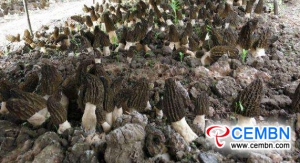ChampFood International is excited to share some recent developments, including the introduction of Luc Baltussen to their sales team. Luc joined the company on May 1st, bringing with him a wealth of experience in supply and logistics management. He made an impressive start by participating in the mushroom days, where he had the opportunity to meet ChampFood relations and industry colleagues in person. Luc's knowledge and skills have made him a valuable addition to the Sales Support department.
Alongside Luc's arrival, ChampFood has also welcomed four other new members to their team, showcasing their strategic investment in the company's future.
These new team members, all under the age of 30, will contribute their unique perspectives and energy to various departments such as production, finance, office management, and purchasing. ChampFood is pleased with their decision to join their company, as they believe investing in young professionals is vital for sustained success.
This picture shows the new team members:
From left to right top row: Aniek Voesten and Ramon Coenen
From left to right bottom row: Luc Baltussen and Remco Sleutels.

In recent years, ChampFood has experienced the retirement of several employees, with more expected in the coming years. This natural transition has presented them with an opportunity to infuse their workforce with fresh talent. Luc and the four new colleagues will help ensure a seamless transition and contribute to their ongoing growth and innovation. ChampFood recognizes the importance of nurturing the next generation of professionals within the mushroom industry.
For more updates please visit: ttps://www.champfood.com/ or follow the company page on LinkedIn: "champfood international"
Reishi Mushroom for Hair Growth
In this article, you’re going to learn about reishi mushroom and how it can grow your hair. You’ll learn of the latest scientific research surrounding this ancient herb, and how you can get started reaping its benefits today.
First, I’ll introduce you to this 2000-year-old herb and its uses in Ancient China.
Second, I’ll dissect recent scientific studies surrounding reishi mushroom and its various properties to determine whether it’s an effective treatment pattern baldness.
Third, I’ll share with you three ways of supplementing with reishi, two of which are my very own hair growth recipes which I’ve personally used with great results.
What is Reishi Mushroom?
Regarded in Asia as the “herb of spiritual potency,” reishi mushroom has been in use for thousands of years alongside other herbs, like Fo Ti. It goes by many names, including lingzhi and G. Lucidum, and grows at the base of deciduous trees.
While wild varieties of this mushroom are rare, lingzhi is cultivated today on hardwood logs and woodchips.
The mushroom itself has a corky texture and is flat-topped. It typically has a red varnish and a kidney-shaped cap, and while other colors do occur, red reishi is the most well-known and studied.
With a variety of therapeutic uses, including immunomodulation and as an antioxidant, it is no wonder researchers have focused in on this versatile mushroom and studied it extensively.
But, the question this article will aim to answer is, “can reishi be used to treat alopecia?”
Mush Comb is growing
Mush Comb is growing and ready for the future
2020 has been a very turbulent year in the market and the mushroom industry. After a challenging first half of 2020, Mush Comb was able to catch up considerably in the second half of the year. Like any other company, there was an ambitious plan to grow, but Corona threw a spanner in the works. The market stalled and everyone switched to survival mode. Fortunately, the tide turned in July, orders came in again and Mush Comb was able to further shape its strategy. The company chose to invest instead of pulling the handbrake.
In November last year, 500 extra square meters of warehouse space, including storage racks, was added to the existing production floor. This made it possible to organize the production area much more efficiently. In October, 5S was introduced and each department has been given its own resources to ensure order and tidiness within production.
Besides expansion in resources and space, considerable investments have also been made on the personnel side. Mush Comb has hired several employees to realize the growth it envisizes in 2021.
In December 2020, the go-ahead was given to build an upper floor on the existing ground floor, so that the office space will also grow in surface area by 100%. The new building will be ready in May 2021, freeing up office space to relocate the engineering department and the canteen.
Despite the current challenging times, Mush Comb dares to invest and looks positively towards the future!





By growing Bamboo fungi in 550 mu of area, the base creates the gross incomes of over 42 million CNY
On July 7, in mushroom base located in Xiongjiachang Town, Bijie City, Guizhou Province of China, Bamboo fungi cultivated in 550 mu of area are in picking season, growers are busy with picking, management and drying work.
“According to the estimation, this year, output of fresh Bamboo fungus could reach at least 500,000 kg, in accordance with the proportion of 7 to 1, the expected output on dried Bamboo fungus totals 7000 kg. To calculate by the present market price of 600 CNY per kg on dried products, the projected gross incomes could come to over 42 million CNY by 2020,” introduces Mr. Yang Tianhong, person in charge of the base warmly, going on that each day, the base organizes nearly 50 farmers to grow and manage Bamboo fungus, and they can get the per capita incomes of 300 CNY per day.
Morel mushrooms are packed with unique fragrance, complete functions and evident effect to food therapy. This kind of mushroom holds the efficacy of tonifying kidney and brain, refreshing while it shows good auxiliary therapeutic effects on dizziness insomnia, weakness of the spleen and the stomach, indigestion and poor appetite. Besides, Morel mushroom also helps prevent and fight with cancer, ward off colds, enhance the immune system and hence it medically shows crucial development value.
Now, in China, market price of dried Morel mushroom is at 1600-2000 CNY per kg. In western European countries, Morels are extremely in tight supply and high price.
Unlike other mushrooms, Morel mushrooms hold poor adaptability, and poor stability in the case of alien cultivation. Therefore, strains isolated by local Morel variety match local surrounding, eliminate the regional differences and influences resulted from long-distance purchasing or the course of mailing.
Wild Morels could be largely foraged during March to May after the rain while they occasionally pop in during August to September in small quantities.
Morel mushrooms hold long growth period, apart from low temperature, they also require large temperature difference that stimulates the differentiation of mycelia.
When water content of soil is lower than 40%, growth of Morel mushroom would be affected. As fruiting bodies substantially occur, relative air humidity in forest is at 80% and general water content of soil is at a range of 40%-50%. Besides, suitable PH Value that fits for growth of Morel mushroom is 7-8, weak scattered light also impels the growth of fruiting bodies.
However, strong direct sunlight does adverse impact to the growth of More;s. In early spring, growers could timely spray water in dry circumstance, and keep soil moist, or growth of fruiting bodies would be restricted. In a word, in early spring, temperature and humidity of growing environment are key elements that guarantee the success of Morels cultivation.
On July 1, in mushroom house built by Shandong Huarong Mushroom Cooperative, Button mushrooms are showing satisfactory growth tendency, growers are orderly engaged with mushroom picking.
“Now, our cooperative absorbs 60 high-standard and thermostatic mushroom houses which totally output 2000 tons of Button mushroom each year, products are mainly supplied to Beijing and other cities in China,” said manager of the cooperative.
Over the years, Wucheng County of Shandong Province keeps on relying on its advantages, and greatly strengthens mushroom industry. Up to now, over 20 cooperatives have been built in the county, area for mushroom cultivation totals over 7 million square meters, annual mushroom output reaches 86,000 tons while output value hits 660 million CNY.

























